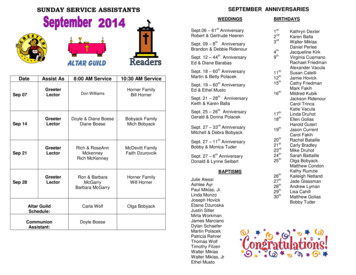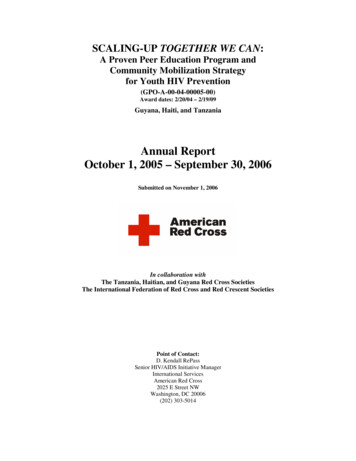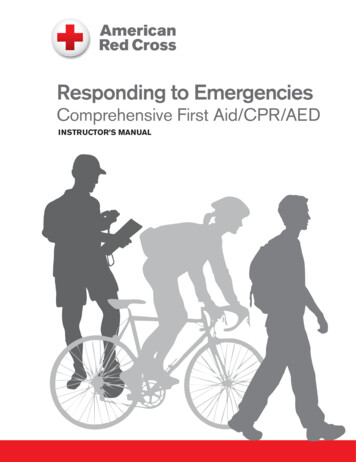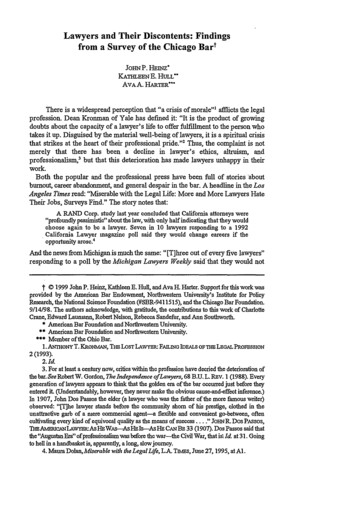
Transcription
National Park ServiceU.S. Department of the InteriorNational Center for Cultural ResourcesNational Park ServiceResponding tothe September 11 Terrorist AttacksJanet A. McDonnell1
2
3
4
The National Park Service:Responding to the September 11 Terrorist Attacks
Library of Congress Cataloging-in-Publication DataMcDonnell, Janet A., 1952The National Park Service : responding to the September 11 terrorist attacks /by Janet A. McDonnell.p. cm.Includes bibliographical references and index.1. United States. National Park Service. 2. September 11 Terrorist Attacks, 2001.I. Title.SB482.A4M338 2004973.931--dc222004026454Cover: U. S. Park Police patrol New York Harbor after the attacks.Inside cover, Maj. Tom Wilkins, U.S. Park Police, holds the American flagduring rescue operations at Ground Zero.
The National Park Service:Responding tothe September 11 Terrorist AttacksJanet A. McDonnellNational Park ServiceDepartment of the Interioriii
Table of ContentsPreface . viiIntroduction . xI. National Park Service’s Initial Response . 1Main Interior Building, Tuesday, September 11, 2001 . 1Continuity of Operations . 4Park Closures . 8Support to the Department of the Interior . 11Conclusion . 13II. National Capital Region . 15U.S. Park Police Headquarters . 15Securing the White House, Monuments, and Memorials. 17Motorcycle Unit . 18Aviation Unit . 19Evacuation of Cabinet Officials . 24Traffic Management . 25Additional Park Police Missions . 26Park Rangers Respond . 26National Mall . 29Catoctin Mountain Park . 30Conclusion . 31III. New York City . 33U.S. Park Police New York field office . 33Manhattan Sites. 36Statue of Liberty and Ellis Island National Monuments . 46ivThe National Park Service: Responding to the September 11 Terrorist Attacks
Gateway National Recreation Area . 55Conclusion . 58IV. Incident Management . 61Convening Incident Management Teams . 61Incident Management System . 64Delegation of Authority . 65Role and Activities of the Type 1 Team . 66Type 2 Incident Management Team—Northeast Region . 70Conclusion . 73V. Challenges . 77Communications . 77Coordination . 80Funding . 85VI. Aftermath . 89Impact on Parks and Visitors . 90Shortage of Law Enforcement Personnel . 95Multi-region Coordination Group . 101Conclusion . 107Notes. 111Oral History Interviews. 123Photo Credits . 125Index . 126Table of Contentsv
viThe National Park Service: Responding to the September 11 Terrorist Attacks
PrefaceThe terrorist attacks of September 11, 2001, and their aftermath leftfew Americans unaffected. As the federal agency with primary responsibility for protecting and preserving many of the nation’s most significant cultural and historic sites, the National Park Service had a uniqueperspective and role in responding to this tragedy. The most profoundpersonal impact within the Service was no doubt on those employeeswho either witnessed the attacks firsthand or were directly involved inthe immediate response, but every national park was affected to onedegree or another.Park Service historians and ethnographers quickly recognized the needto record and preserve the experiences and perspectives of those whohad witnessed or responded to the attacks. They conducted more thana hundred oral history interviews with Service employees throughoutthe country, in parks, regional offices, and the Washington headquarters. These unique interviews reveal the memories and interpretationof the event and aftermath in the words of those directly affected. Inaddition to conducting interviews, there was also a need to documentand evaluate the official response of the National Park Service. With thatin mind, I began to research the following questions: How did Servicemanagers and staff respond at the national level and in the regional andpark offices? What actions did they take and why? How did the attacksand their aftermath affect the way the Service and the parks operated? How did they affect park resources and the allocation of thoseresources? What impact did the attacks have on the way park staffsviewed their jobs and the way Americans viewed their parks? And finally,what lessons could the Service learn from this experience? What did theService’s response say about its values and responsibilities?Simply put, my goal was to foster a deeper appreciation and understanding for the way the Service and its employees responded to the attacksand to create a detailed historical record of this unique and significantperiod in the Service’s history. This history is also designed to provideView of the Statue of Liberty overlooking New York Harbor.vii
Service managers and policymakers with information they might finduseful in responding to future emergencies.Writing this history presented some unique challenges. Many of themajor decisions about the response operations were made in phoneconversations or in meetings with little or no written record. A scarcityof written records meant a greater reliance on the oral history interviewsthat National Park Service historians and ethnographers conducted.This approach involved a certain amount of risk: memories can be faultyespecially after experiencing such a traumatic event; oral accounts cansometimes be confusing or lack specific details.The September 11 event was truly unique in nature and scope. For thefirst time in our history, American commercial airplanes were used asterrorist weapons. Never before had a terrorist attack within the UnitedStates resulted in so many casualties. The resulting story is complex,involving a broad range of perspectives, activities, and locations. Whendealing with such a traumatic and chaotic event, even determining anaccurate sequence of events can be difficult. Memories are powerful.Witnesses were often more likely to recall vividly their sense of shockand fear, the acrid smell of burning debris, or their images of woundedvictims than to recall factual details. Yet both types of information areimportant for the historical record. “The lived experience is more complex than subsequent interpretations reveal,” explains Mary MarshallClark, the director of the Oral History Research Office at ColumbiaUniversity.1 The personal stories conveyed in the interviews reflect thehorror of what witnesses experienced before these stories were turnedinto a more acceptable narrative.This history reveals how the event strained Park Service resources,highlighted vulnerabilities in security, and brought into sharp reliefthe emotional and symbolic power of National Park Service sites, suchas Independence Hall, the Statue of Liberty, and Manzanar. It alsoaddresses deeply embedded cultural values. Weaving these threadstogether proved challenging: there were no historical prototypes orprior research upon which to draw.Finally, without the perspective of time, it is difficult to interpret the fullmeaning and impact of the event. Yet it is important to capture personalviiiThe National Park Service: Responding to the September 11 Terrorist Attacks
stories and operational decisions while memories are fresh. This reportprovides a snapshot of a moment in time, a preliminary assessment, andit highlights the challenges of balancing security with the Service’s statutory obligation to protect resources and provide for public enjoymentof those resources. It reveals the difficulty of making critical decisionsin an uncertain and rapidly changing environment and the difficulty ofresponding to an emergency with a decentralized organizational structure. The goal was not to produce a definitive history of the response butto provide managers with a useful tool and future historians with a foundation upon which they can build.This history would not have been possible without the tremendous support and cooperation from managers and staff throughout the Service.Early on, the Park Service’s Northeast Region recognized the need torecord the experiences and perspectives of employees affected by theattacks and launched a systematic effort to do this. EthnographersChuck Smythe and Mark Schoepfle conducted dozens of oral historyinterviews, which became valuable sources for this history. Doris Fanelli,Louis Hutchins, and George Tselos also conducted interviews.Above all, I am indebted to the dozens of Park Service members whograciously shared their time, experiences, perspectives, and in a fewinstances, their frustrations and anguish, in oral history interviewswith me and other Service historians and ethnographers. Many of theirnames are listed at the end. Rick Gale, Einar Olsen, Dennis McGinnis,Dennis Burnett, and others not only participated in interviews but alsoreviewed the draft manuscript and provided comments. Historians EdLinenthal and Dwight Pitcaithley also reviewed the manuscript andprovided thoughtful comments. I am grateful to Lise Sajewski who,using her love of language and considerable editorial skills, did much toimprove the manuscript. My sincere thanks to Marcia Axtmann Smithfor designing and producing this book with so much skill, creativity, professionalism, and patience. Working and consulting with the individualsmentioned above proved to be a truly rewarding experience.Prefaceix
IntroductionOn the morning of September 11, 2001, a group of foreign terror-ists launched an unprecedented, well-coordinated attack on the UnitedStates using as their weapons four California-bound commercial airliners, each loaded with the maximum amount of jet fuel for its long tripacross the country. The first two hijacked planes slammed into the twotallest towers of the World Trade Center in New York City. These stunning 110-story glass-and-steel towers, which soared above the skylinein Lower Manhattan, had served as a major American business andcommercial center. The third plane struck the Pentagon, and a fourthcrashed in a field eighty miles southeast of Pittsburgh.At 8:45 a.m. (EST) American Airlines Flight 11 carrying ninety-twopeople from Boston to Los Angeles crashed into the North Tower ofthe World Trade Center. Twenty minutes later, United Airlines Flight175 with sixty-five passengers and crew also heading toward Californiaripped through the South Tower. At 9:40 a.m. (EST) American AirlinesFlight 77, a Boeing 757 commercial airliner carrying sixty-four peopleand 30,000 pounds of fuel for its long flight from Dulles to Los Angeles,smashed into the west façade of the Pentagon with such force that itpenetrated four of the building’s five interior rings. The Federal AviationAdministration promptly banned takeoffs nationwide and ordered allflights that were in the air to land at the nearest airport. Then camethe alarming news that United Airlines Flight 93 with forty passengers and crew en route to San Francisco had crashed in Shanksville,Pennsylvania. Not long after, reports circulated that this plane had beenheaded toward Washington, D.C., and heroic passengers had intervenedto thwart this plan. Back in New York, shortly before 10:00 a.m. (EST)the South Tower of the World Trade Center crumbled to the groundkilling most of those trapped inside and blanketing Lower Manhattanwith a thick coat of debris and dust. Approximately a half hour later, theNorth Tower tumbled down as well. None of the passengers and crewson the planes survived. Thousands of people were injured or killed atthe World Trade Center and Pentagon.xThe National Park Service: Responding to the September 11 Terrorist Attacks
In its long history the National Park Service has rarely had to worryabout war threatening the safety of its visitors or the integrity of thenatural and cultural resources that are under its protection. The terrorist attacks and their aftermath had a profound impact on the nationalparks—and on the National Park Service and its employees. The attacksreaffirmed the importance of parks as venerated symbols American values and culture. The events, traditions, and values represented at theparks, particularly at the historic sites, took on new resonance for theAmerican public and for employees struggling to come to grips with thenature and scope of the tragedy. The Statue of Liberty, St. Louis GatewayArch, Liberty Bell, Washington Monument, and the other landmarksthat the Service is charged with protecting help define Americans as apeople. Yet, at the same time, the attacks exposed these venerated sitesas potential targets.The attacks and the response highlighted the critical role that the ParkService plays in the life of the nation and challenged the agency to reassess and reaffirm its missions, priorities, and resources. A careful studyof the way leaders, managers, and staff responded reveals much aboutService’s culture, values, and responsibilities.Though it is far too soon to identify and evaluate the long-term impactof the attacks, in some ways September 11 has been a transforming eventfor the National Park Service. The event prompted changes in the waythe Service operates and is organized, and for many, gave the parks newmeaning and significance.Introductionxi
xiiThe National Park Service: Responding to the September 11 Terrorist Attacks
Much like the rest of the country,in those first hours Serviceleaders were stunnedby the attacks and struggledto understand the full scopeand implications of whathad happened.I. National Park Service’s Initial ResponseMain Interior Building, Tuesday, September 11, 2001Rick Gale, chief of the National Park Service’s fire aviation emergencyresponse and head of its incident management program, was sitting inAssociate Director Richard (Dick) Ring’s third floor office in the Department of the Interior’s Washington, D.C. headquarters, when a call camein advising Ring to turn on the television. It would prove fortuitousthat Gale who normally worked at the National Interagency Fire Centerin Boise, Idaho, happened to be in Washington that day. Ring turnedon the television just in time to see the second plane strike the WorldTrade Center in New York City. Gale headed back to his temporaryoffice in the ranger activities division. Not long after, Ring received wordthat the Pentagon had been struck. He stepped outside onto his smallbalcony and glancing south saw an ominous cloud of smoke rising in thedistance.1Meanwhile, a few floors above, the acting chief of the Park Serviceranger activities division, Dennis Burnett, was working at his computerwhen an employee ran down the hallway announcing that a plane hadhit one of the World Trade Center towers. Burnett walked down to thevacant office of chief of ranger activities at end of the corridor, wherehe knew there was a television. After checking the news, he returnedto his office. Moments later, he learned of the second plane attack. Atthat point, Burnett gathered his small staff, which included nationallaw enforcement specialist Maj. Gary Van Horn, U.S. Park Police, andSearch and Rescue Emergency Medical Services Coordinator RandallAmerican flag framed by the rubble at the World Trade Center after the attacks.Above, Pentagon damage.1
Around 10:00 a.m. federal authorities orderedgovernment offices closed and approximately 260,000federal workers in Washington began pouring out into the streets.Coffman. They headed to the department’slaw enforcement security office, where theycontinued to monitor the television newscoverage.2Major Van Horn, an experienced career lawenforcement officer, quickly recognized theneed to immediately locate the Service’sdecision-makers and get them to a securelocation in case there were incidents inthe Washington area. He hurried back tohis office and got on his police radio. Afterlearning of the Pentagon attack, Van Hornbecame concerned about potential threatsto the monuments and memorials on theNational Mall. He climbed into his policecruiser and quickly drove to each of thesemonuments and memorials to conductquick inspections and to make sure thatPark Police officers were in position in theevent of another attack. He spotted a suspicious package on the Memorial Bridge,a major route in and out of downtownWashington, and waited there until moreofficers arrived. After assuring himself thatthe bridge was secured, he returned to theMain Interior Building.3Meanwhile, Burnett and other employeesin Main Interior discovered that they couldno longer make outgoing phone calls oneither landlines or their cellular phones.Wireless networks had collapsed under the2barrage of calls. When Burnett’s daughtercalled to check on him a half hour after thePentagon attack, he used this opportunityto establish what would become an important phone link. He asked his daughter tohave the Eastern Interagency CoordinationCenter (EICC), a dispatch center located inShenandoah National Park, call him. Whenthe center contacted him, he asked the staffto continue calling every twenty minutes sothat they could maintain a landline connection. Although phone service was severelyrestricted, Burnett was able to send ane-mail message to the regional chief rangersand to the dispatch center, informing themthat the Washington headquarters had nocommunications capability.4In his message, Burnett asked the dispatch center to become the agency’s“eyes and ears.” He directed parks andregions to channel all their messages forthe Washington office through the center.Finally, he reported that the departmenthad activated its continuity of operationsplan and was relocating people in accordance with that plan. In another messagehe encouraged regional chief rangers tostep up security at Park Service facilitiesand sites.5The EICC had been established atShenandoah National Park in Virginia inThe National Park Service: Responding to the September 11 Terrorist Attacks
1980 and had grown from a small centerthat coordinated responses to fires andlocal emergencies into a national coordination center. Combined with the coordination center was a communications centerthat provided emergency notifications ofcrisis situations and mobilizations for thePark Service, other federal agencies suchas the Federal Emergency ManagementAgency (FEMA), and for senior department officials. While the communicationscenter did the notifications, the coordination center directed the actual mobilizationand demobilization of resources within theService.Upon learning of the attacks, the center’smanager, Brenda Ritchie, an experiencedemergency operations manager, immediately called in additional dispatchers tostaff the communications center. Her firsttask was to contact senior departmentofficials to find out where they were andverify that they were safe and to determinethe status of all the parks and employeesin the Park Service’s Northeast Region. Asalready noted, initially officials in the MainInterior Building were unable to makeoutgoing calls, so the center called themevery fifteen to twenty minutes. Faced withmajor communications problems, Ritchiequickly arranged to bring in a mobile satellite truck, a so-called cellular on wheels.The satellite truck and 150 cellular phonesarrived within the first eight hours, andthe center distributed the phones to keymanagers and operational staff. Bringingin the satellite dish on such short noticewas no small feat and required unprecedented cooperation between two majortelecommunications companies—Verizonand Sprint. As a result, phone service wasrestored to most sections of the MainInterior Building.6The center performed the communications role for both the Service and theDepartment of the Interior. It provideddirect support to the parks and also toFEMA in New York and New Jersey. Whenthe staff for the intelligence, coordination,and communications functions grew tomore than twenty people, it became clearthat the modest 1950s-era building that hadhoused the communications center in thepast could not hold them all. Ritchie gotapproval to bring in a trailer to house thecoordination center.7Meanwhile, back in Washington, director of the National Park Service FranMainella; Pacific West Regional DirectorJohn Reynolds (who was acting as deputydirector at the time); Associate Directorfor Administration Sue Masica; AssociateDirector for Cultural Resources andPartnerships Kate Stevenson; Dick Ring;Dennis Burnett; and others gathered in thedeputy director’s third floor office to plan acourse of action. They quickly recognizedthe need to get to a safe environment wherethey would have effective communications.8When Rick Gale joined the group, Reynoldsintroduced him to the director and recommended him to Mainella as someonewith extensive experience in emergencyresponse. Dick Ring suggested that Galestay close to the director to enhance communication and coordination with thedepartment. He also wanted Gale to coordinate the director’s activities, communications, and directions regarding the emergency operations within the Service. Thedirector quickly tapped Gale to go with herto meet with department leaders on theI. National Park Service’s Initial Response3
sixth floor. Gale would remain close to thedirector throughout the day and in the daysthat followed. He offered her advice onhow best to organize the Service’s responseand laid out possible missions. In effect,Gale became a self-described soundingboard for the director.9Much like the rest of the country, in thosefirst hours Service leaders were stunnedby the attacks and struggled to understandthe full scope and implications of whathad happened. They were just beginningto receive some reports from the ParkPolice about its security-related activitiesand about the worsening traffic situationaround the city. The leaders were notaware of any specific immediate threatsto or attacks on any National Park Serviceareas, so they were not yet focused onplanning a Service-wide response. Theyknew that Federal Hall and Castle ClintonNational Monuments were located nearthe World Trade Center, but they did notyet know the status of those parks. Littleinformation came out of New York in thosefirst hours. Service leaders had concerns,but with landlines down and cellularphone system overloaded, they had littlesolid information and chose to proceedcautiously. Years earlier, as superintendentof Everglades National Park whenHurricane Andrew struck, Ring had learnedthat the best approach was to proceedslowly and to gather solid informationbefore taking action. Since there were noreports of a park being struck, he believedthe immediate task was simply to gathermore information.10The director issued “Emergency OperationsInstructions,” authorizing all regional directors, at their discretion, to reduce their4staffs to essential personnel only. She specified that, if possible, parks should continueminimum operations with basic visitorcontact services, provide updates on theincidents, and monitor television and radioreports. She directed that campgroundsremain open as appropriate. Finally, thedirector encouraged superintendents toadvise their employees to become moresecurity conscious.11As the morning progressed, Service leaders learned that the federal government inWashington was shutting down its operations. Around 10:00 a.m. federal authorities ordered government offices closed andapproximately 260,000 federal workersin Washington began pouring out into thestreets.12 Secretary of the Interior GaleNorton ordered the evacuation of the MainInterior Building and released a memo dismissing all nonessential employees for theremainder of the day. Her memo indicatedthat the dismissal would remain in effectthe next day September 12, unless employees were informed otherwise.13Continuity of OperationsWhen officials gathered in the deputydirector’s office, one of the first topicsunder discussion was the need toimplement the Service’s continuity ofoperations plan. The National Park Serviceheadquarters, each regional and supportoffice, and some individual parks hadwhat is called a continuity of operationsplan, which outlines specific measuresto ensure that operations continue assmoothly as possible during an emergency.Park Service continuity of operationsplans were designed to correspond to thedepartment’s continuity of operationsThe National Park Service: Responding to the September 11 Terrorist Attacks
The National Park Service headquarters, each regionaland support office, and some individual parks hadwhat is called a continuity of operations plan,which outlines specific measures to ensure that operationscontinue as smoothly as possible during an emergency.plan. The department’s plan spelled outthe succession of authority and providedfor the removal of the secretary, deputysecretary, and each bureau head to a remotelocation well outside the Washington area.The plan specified that the National ParkService director would go to the samelocation as the secretary or to anotherlocation specified by the secretary.14Initially the secretary wanted departmentand bureau leaders to go to what the plandesignated as Site B—an office about tenmiles away in Northern Virginia. Leadersconsidered Site B to be a safe locationwhere they could organize the department’s operations. The director and RickGale got in a car to drive to the site, butwith the horrendous traffic congestion indowntown Washington it took them twentyminutes just to get out of the Main InteriorBuilding’s underground parking garage.As the minutes passed, Gale observed thatwith cellular phone systems overloaded, thedirector would be without any communications link for hours while she sat in traffic.The director agreed with his assessment.They got out of the car and went back upto the sixth floor. Soon after, the department set up operations in the department’sNational Business Center conference roomin the basement, presumably the safest partof the building. The large conference roombecame the department’s coordination center. The director joined Deputy Secretaryof Interior J. Steven Griles and other keydepartment leaders there.15Later in the day, the secretary decided torelocate to what the department’s continuity of operations plan designated as SiteC, an hour’s drive outside Washington. Asnoted, the plan provided that the directorand other bureau heads would join department leaders at this alternate site. TheService’s own continuity of operations planprovided that its deputy director and othersenior leaders would go to the Service’sdesignated site in West Virginia. This facility had a conference room outfitted withextra phone lines and all the other equipment these leaders would need to continue their management functions. Staffs atboth alternate sites quickly and efficientlyorganized to receive the senior managers.16At the request of department officials, aU.S. Park Police SWAT team came to theMain Interior Building and escorted seniordepartment officials to Site C.17Major Van Horn offered to escort thedirector to the alternate site, and beingfairly new to the Service and unfamiliarwith the site, she gratefully accepted. Heled the way in his police cruiser, while theI. National Park Service’s Initial Response5
Reflecting the White House’s desire for the federal governmentto resume normal operations as quickly as possible,Secretary Norton made it clear that she expectedas many parks as possible to be open on September 12.director followed close behind in her ownvehicle. They stopped at her home first soshe could pack some extra clothing. Whileshe did this, Major Van Horn
Inside cover, Maj. Tom Wilkins, U.S. Park Police, holds the American flag during rescue operations at Ground Zero. Library of Congress Cataloging-in-Publication Data McDonnell, Janet A., 1952-The National Park Service : responding to the September 11 terrorist attacks / by Janet A. McDonnell. p. cm. Includes bibliographical references and .









